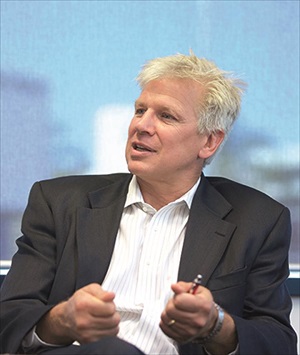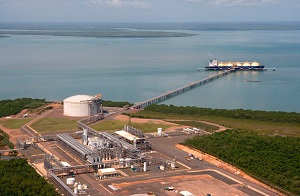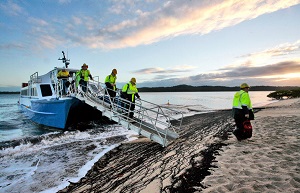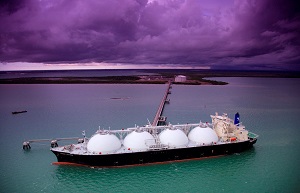Stripping Cost out of Australian Gas
The commercial start-up of Train 1, scheduled for Q4 2015 at Australia Pacific LNG’s (APLNG) Curtis Island facility, will have been yet another important milestone for the country’s gas export ambitions.
The multi-billion dollar plant in Queensland produces LNG from coal seam gas (CSG). LNG’s environmental advantages over coal are additional selling points in markets that see natural gas as a transition fuel while they wind down coal use and ramp up renewables.
 “We knew there would be demand from countries within Asia Pacific with insufficient domestic gas supplies,” said Warwick King, president, ConocoPhillips Australia East. The U.S. oil and gas company is a foundation shareholder of APLNG, and responsible for operating and maintaining the LNG facility on behalf of the joint venture.
“We knew there would be demand from countries within Asia Pacific with insufficient domestic gas supplies,” said Warwick King, president, ConocoPhillips Australia East. The U.S. oil and gas company is a foundation shareholder of APLNG, and responsible for operating and maintaining the LNG facility on behalf of the joint venture.
“As people develop greener perspectives and switch fuels, LNG will be seen as a cleaner preferred option, particularly where emissions are a major concern,” he added.
The two-train facility is supplied entirely from APLNG’s equity gas resources, which are transported via a 530-kilometer (330 miles) pipeline from the Surat and Bowen Basins.
The two trains will have a name-plate capacity of nine million tons per annum (mtpa) with take-or-pay contracts with Sinopec and Japan’s Kansai Electric Power Company. Shipments are by LNG tanker from Curtis Island.
Work on the LNG facility started in 2011. King expects Train 2 to be operating commercially by late Q2 2016. Bechtel, the engineering, procurement and construction contractor for both trains, is expected to be off-site in late 2016.
Technical improvements
ConocoPhillips’ proprietary Optimized Cascade process for LNG production was utilized. The technology has a 40-year record of success and continuous improvement worldwide, and presented few technical challenges on Curtis Island, King said.
 Lessons learned from ConocoPhillips’ LNG plant at Darwin, Northern Territory, Australia, have been applied at Curtis Island. These include installing reversing gears in cooling-system fans to prevent them spinning the wrong way in high winds.
Lessons learned from ConocoPhillips’ LNG plant at Darwin, Northern Territory, Australia, have been applied at Curtis Island. These include installing reversing gears in cooling-system fans to prevent them spinning the wrong way in high winds.
The Darwin facility was one of the first LNG plants to operate in Australia and also uses the Optimized Cascade process as the basis for its liquefaction technology. It has a design capacity of 3.7mtpa and was commissioned in January 2006, so has generated nearly a decade of lessons for the wider group.
King hopes that APLNG will become the company’s most efficient LNG facility. “We can apply latest technologies and learn from earlier plants. With this head start, we should be able to send learnings back to ConocoPhillips’ other facilities.”
The greatest challenge
Logistics have been the biggest challenge. Every component is shipped to the island.
“We have had to transport rock, cement, piping, equipment and people across to the island,” King said. “Contractors had to ensure everything turned up on time.” On APLNG’s site alone, there were 3,300 people during peak construction.
“The three facilities on Curtis Island have slightly different designs but they are fairly similar. As a result, we often have to use the same vendors for the same work due to its specialized nature. When projects overlap, demands on people, time and equipment are significant.”
B echtel, which ConocoPhillips licenses to install Optimized Cascade process systems, is the main contractor on all three plants. “That was an advantage logistically,” King emphasized. “There has been cooperation with the other LNG proponents in some areas as the projects progressed.” For example, APLNG links to the same sewerage and freshwater systems as the other two facilities.
echtel, which ConocoPhillips licenses to install Optimized Cascade process systems, is the main contractor on all three plants. “That was an advantage logistically,” King emphasized. “There has been cooperation with the other LNG proponents in some areas as the projects progressed.” For example, APLNG links to the same sewerage and freshwater systems as the other two facilities.
The proponents are also looking to collaborate over a future operator trainee program and to share some emergency response arrangements. King commented: “We have been liaising with the regulator regarding the possibility of collaborating in the context of shutdown scheduling to maintain safety and improve efficiency.
“As the three projects all move into production phase, there is a real understanding that there are areas where working together can be good for everyone – operators, contractors and local communities.”
A long-term perspective
This long-term view is evident from many of King’s remarks. While Sinopec and Kansai Electric have 20-year take-or-pay agreements, he expects the Curtis Island plant to operate for 10 to 20 years beyond that.
Long-term relationships with suppliers are core thinking for ConocoPhillips. “We want suppliers who share our values, are strongly committed to safety, and who are driven to find win-win solutions with us in both good and bad times.”
The operator values local content and engagement with indigenous communities in its contracting relationships.
“Near-term, most contracts for Curtis Island are awarded. However, I see long-term opportunities for companies with a heritage of working with ConocoPhillips and with which we have global agreements.”
This approach also drives ConocoPhillips’ human resources strategy for its LNG plants in Australia. To help attract and retain skills, it introduced a program to recruit and train people in the company’s values and ways of working. King feels this initiative gives the ConocoPhillips facility a competitive advantage on Curtis Island.
Even during the capital expenditure phase, the company was mindful of how design would later impact upon operating expenditure for the facility. It built into the Curtis Island LNG plant’s infrastructure many access points for easy, non-intrusive inspection.
Data prepared and collected by Bechtel will eventually be delivered to ConocoPhillips. “There is a phenomenal amount,” said King. “It is drawings, specifications, equipment and procedures, and we will add data gathered day-to-day. We have a group looking at data management and intend to, and need to, become very good at it.”
Expansion in Australia
 Looking to the future, he said: “The current situation in oil and gas markets has to be considered in the context of timescales of an LNG project. Our LNG plant is due to operate for 30 to 40 years.”
Looking to the future, he said: “The current situation in oil and gas markets has to be considered in the context of timescales of an LNG project. Our LNG plant is due to operate for 30 to 40 years.”
ConocoPhillips is expected to invest in Australia for years to come, he stressed. “I would clearly like to see us expand further here.”
The Curtis Island operation has a number of environmental approvals for four liquefaction trains. “A third could be added potentially without the need for a third storage tank,” King said. “If a large increase in gas resources became available to the east coast, LNG plants here could be interested in leveraging their existing infrastructure.”
Gas versus coal
Natural gas is a dependable baseload fuel source for homes, businesses and power generation. It is in rising demand in growth economies switching energy dependence toward renewables such as wind, whose output is intermittent. The relative cleanliness of natural gas is another selling point. Burning LNG from coal seam gas (CSG), for example, emits 50 percent fewer greenhouse gases than coal.
Experts at engineering consultants WorleyParsons estimate that for every ton of carbon emitted in Australia from LNG production, 4.3 tons are avoided globally when China uses LNG instead of coal to generate power.
CSG is abundant onshore eastern Australia, providing part of the country’s natural gas supply, and offering a substantial export opportunity. APLNG has Australia’s largest CSG resource, some of which will be sold domestically. Its Curtis Island facility will export LNG to the global market.

that matters most
Get the latest maritime news delivered to your inbox daily.
Australia is set to become both the biggest producer and exporter of LNG in 2018.
Source: DNV GL’s PERSPECTIVES magazine
The opinions expressed herein are the author's and not necessarily those of The Maritime Executive.
